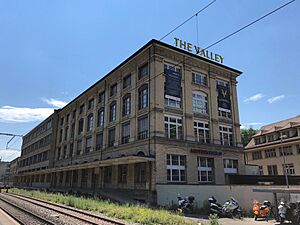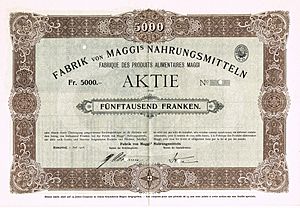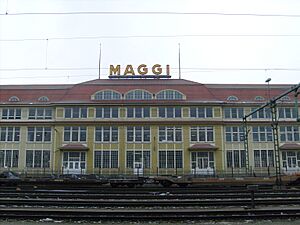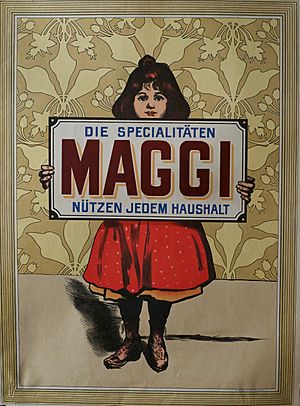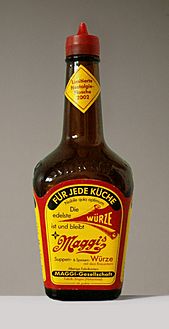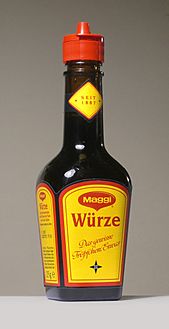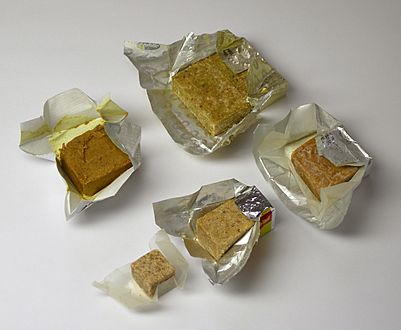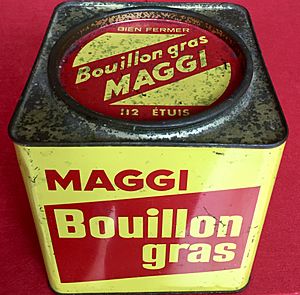Maggi facts for kids
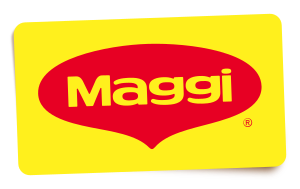 |
|
| Food | |
| Founded | October 2, 1798 1884 |
| Founder | Julius Maggi |
| Headquarters |
Switzerland
|
| Parent | Nestlé |
Maggi is a well-known international brand. It makes many different food products. These include seasonings, instant soups, and noodles. Maggi started in Switzerland in the late 1800s. The company became part of Nestlé in 1947.
Contents
Maggi: A Flavorful History
How Maggi Started
In 1869, a man named Julius Maggi took over his father's mill business. This was in Kemptthal, Switzerland. Julius Maggi was a pioneer in making food in factories. His goal was to help working families eat better. He wanted to provide more nutrients and make food faster to prepare.
In 1882, a doctor named Fridolin Schuler spoke about factory workers' poor diets. Women workers often didn't have time to cook. Meals were sometimes cold or not very nutritious. This led to health problems. Schuler suggested that workers needed easy-to-cook, healthy meals. He thought meals made from legumes (like beans or lentils) would be good. These foods are high in protein and easy to digest.
The "Swiss Common Good Society" asked Maggi to help. Julius Maggi spent two years experimenting. He tried different ways to process legumes. On November 19, 1884, he showed his results. The Society liked his ideas. They agreed to recommend Maggi's legume products. Maggi promised to keep prices low and check product quality.
Since 1884, Maggi has offered flour made from protein-rich legumes. These flours could be cooked quickly. Maggi was the first company to sell such legume meals.
Growing Around the World
By 1885, Maggi sold nine types of legume flour. He won an award at a Swiss food exhibition. In 1886, Maggi created a new product: "Maggi seasoning." This seasoning could be used with legume meals. It made a ready-made soup. It was a competitor to meat extracts.
Maggi started opening warehouses and offices in other countries. Maggi GmbH in Singen, Germany, opened in 1887. To get more money for growth, the company became a public limited company in 1889. Julius Maggi became its general director. In 1908, Maggi introduced the bouillon cube. This cube replaced older liquid bouillon concentrates.
Julius Maggi also cared about his workers. He offered many benefits that were unusual for his time. These included a canteen and housing for workers. He also provided health insurance and pensions. In 1906, he even introduced no work on Saturdays. In 1907, he helped solve a worker strike. He suggested creating a "workers' committee." In 1912, Maggi signed the first collective agreement in the German food industry.
From 1902, Julius Maggi lived mostly in Paris. He helped the company succeed in France. Maggi sold a lot of pasteurized milk. By 1912, they sold 60 million liters of milk. They also sold 6 million KUB bouillon cubes each month.
Julius Maggi passed away in 1912. After his death, the company changed its structure. It became a holding company called Allgemeine MAGGI-Gesellschaft. In 1933, Maggi opened a new sauce factory in France. In 1940, another factory opened in the USA.
Maggi During Wartime
During World War I, some people in France thought Maggi was a German company. They accused it of spying. Maggi had to work hard to correct this idea. In 1919, the French branch changed its name.
During World War II, the German Maggi branch faced challenges. It had to work closely with the government. Maggi received a special contract to supply the army. Two-thirds of Maggi's production went to the army during the war.
After World War II, the German Maggi branch was saved. The Swiss government and the Red Cross helped. In 1947, Maggi merged with Nestlé. This merger also helped to improve Maggi's image after the war.
Recent History
In 1947, Maggi joined with the Nestlé company. They formed Nestlé-Alimentana S.A. Today, it is known as Nestlé S.A. The merger of Maggi and Nestlé took several years. They had to combine different products and ways of selling. But in the end, they worked well together.
New production sites opened in Germany. One was in Lüdinghausen in 1964. Another opened in Teutschenthal in 1992. In 2002, Nestlé sold the Maggi site in Kemptthal. This included the flavoring production.
Marketing Maggi
By 2020, Maggi started a new plan called "Simply Good." This plan aims to use healthier ingredients. It also works to reduce the salt content in Maggi products.
Maggi's Products
Bouillon Cubes
The bouillon cube, or Maggi cube, was first sold in 1908. It is a product that can be used as a meat substitute.
Maggi cubes are very popular in many countries. These include Germany, many parts of Africa, and the Middle East. In Haiti and across Latin America, Maggi products are widely sold. They are often packaged to fit local names.
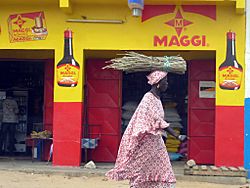
Seasoning Sauce
In many places, "Maggi" means Maggi seasoning sauce. This is a dark sauce, similar to soy sauce. It is made from hydrolyzed vegetable protein. You can find it in Mexico, Germany, the Netherlands, and France. In Spain, it is called Caldo Maggi. In Mexico, it is known as Jugo Maggi.
There are nine different types of Maggi seasoning sauce. They taste different depending on the country.
- Older German and Swiss Maggi sauces used soy protein. Around 2006, the German product changed. It now uses wheat protein and has less salt.
- The Chinese version, common in North America, has no MSG. People say it has a stronger flavor.
- The Mexican Jugo is darker and thicker.
- The Philippines has two versions. Maggi Savor is like other versions. Maggi Savor Calamansi has a strong citrus taste.
In some languages, lovage is called Maggi herb. This is because it smells like Maggi sauce. But lovage is not actually in the sauce.
Instant Noodles
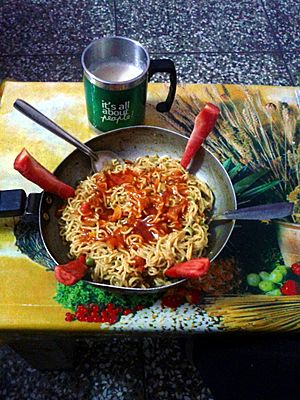
Maggi instant noodles are very popular. You can find them in Bangladesh, South Africa, India, and many other countries. In some places, "Maggi" is almost another word for instant noodles.
In Malaysia and Singapore, fried noodles made with Maggi noodles are called Maggi goreng. In Australia, New Zealand, and India, Maggi Instant noodles are called "Maggi 2 Minute Noodles."
In India, Maggi Masala noodles have a green dot. This means they are made for vegetarians. Maggi chicken noodles have a red triangle. This shows they are not vegetarian. These special types are usually only found in India.
In the Philippines, Maggi instant noodles were sold until 2011. They were recalled due to a possible problem. They have not returned to the market there.
Recipe Mixes
Maggi introduced recipe mixes, or "Fixes," in Germany in 1974. These products give people ideas and recipes. You can use them with a few fresh ingredients and a Maggi mix. The package has step-by-step instructions.
These mixes became very popular in Germany and other European countries. In the 1990s, they came to Eastern Europe. They were a big hit in Russia and Poland. Today, there are over a hundred different Maggi recipe ideas.
See also
 In Spanish: Maggi para niños
In Spanish: Maggi para niños


